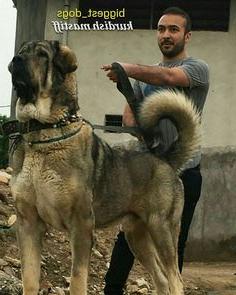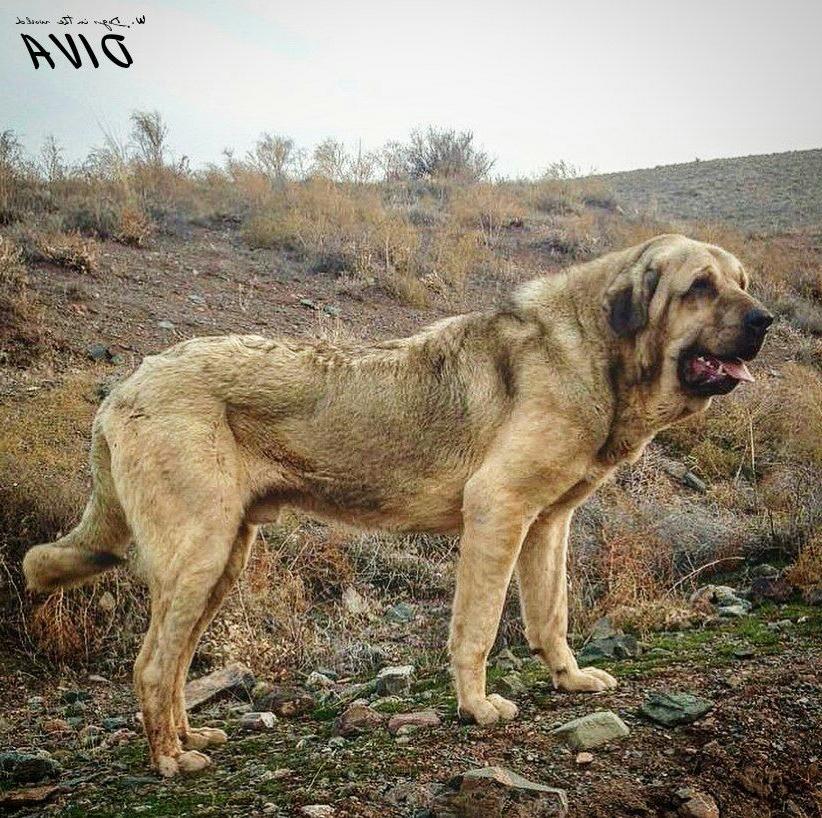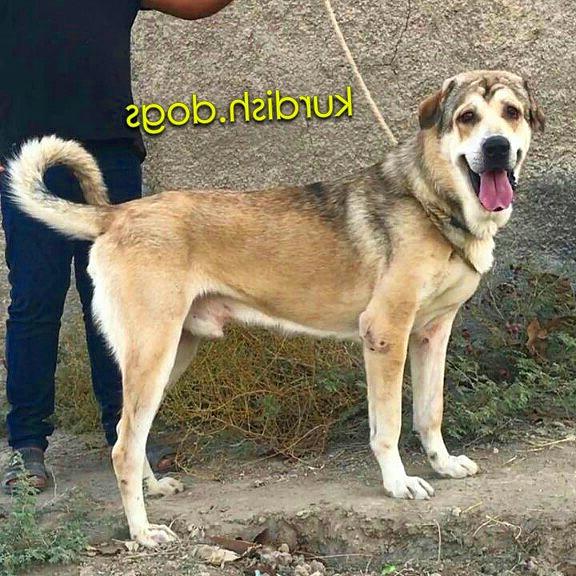- Breed Category: Working Dog
- Country of Origin: Kurdistan Region
- Average Height: Males 75-85 cm, Females 70-80 cm
- Average Weight: Males 50-70 kg, Females 40-60 kg
- Average Life Span: 10-12 years
- Grooming Requirements: Moderate, regular brushing needed
- Exercise Requirements: High, needs daily exercise
- Coat Type: Short and dense
- Coat Color Variations: Fawn, brindle, black
- Shedding Level: Moderate
- Ear Type: Droopy
- Tail Type: Long and curved
- Temperament: Loyal, protective, independent
- Intelligence Level: High
- Barking Tendency: Low to moderate
- Compatibility with Children: Good with proper socialisation
- Compatibility with Other Pets: Varies, early socialisation important
- Training Ease: Moderate, requires experienced handler
- Common Health Issues: Hip dysplasia, bloat
- Dietary Needs: High-quality, protein-rich diet
- Energy Level: High
- Drooling Tendency: Moderate
- Sensitivity to Weather: Tolerant to cold, less to heat
- Overall Maintenance Level: Moderate
- Original Purpose: Livestock guardian
- Apartment Friendly: Not ideal, needs space
- Best Suited For: Rural or suburban homes
- Cost of Ownership: Moderate to high
- Unique Traits: Strong protective instincts
- Cultural Significance: Valued in Kurdish culture
Think all mastiffs are the same? Let’s dive into the unique world of the Kurdish Mastiff, a breed that stands out with its distinct characteristics and rich history. Known for their impressive size and protective nature, these dogs have been guardians of livestock and homes for centuries. This article aims to inform you about the Kurdish Mastiff’s traits, historical roots, and how to care for them.
The Kurdish Mastiff, also known as the Pshdar dog, hails from the rugged terrains of Kurdistan. These dogs have been bred for their strength and loyalty, making them ideal protectors. Their history is intertwined with the nomadic tribes of the region, who relied on them for safeguarding their flocks and families.
Early Development and Cultural Significance

Early Development of the Breed
The Kurdish Mastiff has roots that stretch back centuries. Originally bred in the harsh landscapes of Kurdistan, these dogs were developed for their resilience and strength. They were essential for protecting livestock from predators and thieves, a role they excelled in due to their size and courage. Over time, selective breeding honed their natural instincts, creating a breed that is both formidable and loyal.
Role in Kurdish Culture and History
In Kurdish culture, the Mastiff is more than just a working dog. It’s a symbol of protection and loyalty. These dogs have been part of Kurdish life for generations, often seen as family members. Their presence in Kurdish folklore and stories highlights their importance, not just as guardians but as companions.
Key Historical Figures and Regions
The Pshdar region is particularly noted for its association with the Kurdish Mastiff. Historical figures, such as tribal leaders, often kept these dogs as a sign of status and power. Their reputation spread beyond the region, making them sought after by those who valued their protective nature.
Physical Characteristics
Physically, the Kurdish Mastiff is impressive. They are large, muscular dogs with a commanding presence. Their thick coat provides protection against the elements, while their strong jaws and alert eyes speak to their role as protectors. Despite their size, they move with surprising agility, a testament to their well-balanced build.
Appearance and Unique Traits
The Kurdish Mastiff is a sight to behold. These dogs are large, with a robust and muscular build that commands attention. Their coat is typically thick and dense, offering protection against harsh weather. Colours range from fawn to brindle, often with distinctive black masks or markings that add to their striking appearance. Their eyes are sharp and alert, always on the lookout, which complements their role as vigilant protectors.
One of the most unique physical traits of the Kurdish Mastiff is their powerful and protective build. They have a broad chest and strong limbs, designed for endurance and strength. This makes them not only excellent guardians but also capable of covering rough terrain with ease. Their agility is surprising for their size, allowing them to move swiftly when needed.
Temperament and Behaviour
When it comes to temperament, the Kurdish Mastiff is known for its loyalty and protective nature. These dogs are naturally wary of strangers, making them excellent watchdogs. However, they are gentle and affectionate with their family, forming strong bonds with those they trust. Their intelligence and independent nature mean they require consistent training and socialisation from an early age. With the right guidance, they are both reliable companions and formidable protectors.
Personality Traits and Family Suitability

Typical Personality Traits
The Kurdish Mastiff is a breed that embodies loyalty, protectiveness, and intelligence. These dogs are fiercely devoted to their families, always ready to stand guard and ensure the safety of their loved ones. Their intelligence is evident in their quick learning and problem-solving abilities, making them both reliable and adaptable companions.
Suitability as a Family Pet and Guardian Dog
As a family pet, the Kurdish Mastiff is both a loving companion and a vigilant guardian. Their protective instincts make them excellent watchdogs, while their gentle nature with family members ensures they fit well into a household setting. They thrive in environments where they can form strong bonds with their human family, providing both companionship and security.
Interaction with Children and Other Animals
These dogs are generally good with children, displaying patience and gentleness. However, due to their size and strength, supervision is recommended during interactions with young kids. With proper socialisation, they can coexist peacefully with other animals, although their natural guarding instincts may require careful introductions.
Training and Exercise Needs
Training a Kurdish Mastiff requires consistency and patience. Their intelligence means they pick up commands quickly, but their independent streak can sometimes pose a challenge. Regular exercise is essential to keep them healthy and happy, with activities that engage both their body and mind. Long walks, play sessions, and mental stimulation are key to maintaining their well-being.
Training, Exercise, and Health

Importance of Early Training and Socialisation
Starting early with training and socialisation is crucial for the Kurdish Mastiff. These dogs are naturally protective, so exposing them to various environments, people, and other animals helps them develop into well-rounded adults. Early training sets the foundation for a balanced temperament, ensuring they are both confident and manageable.
Recommended Training Techniques
Positive reinforcement is the way to go with these intelligent dogs. They respond well to rewards and praise, making training sessions enjoyable for both you and your dog. Consistency is key, as their independent nature can sometimes lead to stubbornness. Short, engaging sessions work best to keep their attention.
Daily Exercise Requirements and Activities They Enjoy
The Kurdish Mastiff needs regular exercise to stay fit and happy. Daily walks are a must, but they also enjoy activities that challenge their minds, like puzzle toys or obedience training. These dogs love to explore, so a secure yard where they can roam safely is ideal.
Health and Lifespan
Generally healthy, the Kurdish Mastiff can live up to 12 years with proper care. Regular vet check-ups, a balanced diet, and exercise are essential to keep them in top shape. Being a large breed, they may be prone to joint issues, so monitoring their weight and activity levels is important.
Health and Care for the Kurdish Mastiff

Common Health Issues
The Kurdish Mastiff is generally robust, but like many large breeds, they can face certain health challenges. Joint issues, such as hip dysplasia, are common due to their size. Regular vet visits are crucial to catch any potential problems early. Keeping an eye on their weight can also help prevent strain on their joints.
Average Lifespan and Health Tips
With good care, these dogs can live up to 12 years. A balanced diet and regular exercise are key to their longevity. Providing them with a mix of physical and mental activities keeps them engaged and healthy. Regular check-ups with the vet ensure any health issues are addressed promptly.
Preventative Care Recommendations
Preventative care is all about staying ahead of potential health issues. Regular vaccinations, flea and tick prevention, and dental care are essential. Monitoring their diet and ensuring they get enough exercise helps maintain a healthy weight, reducing the risk of joint problems.
Grooming and Maintenance
Their thick coat requires regular grooming to keep it in top condition. Brushing a few times a week helps reduce shedding and keeps their coat healthy. Bathing should be done as needed, but not too frequently, to avoid stripping natural oils. Regular nail trimming and ear checks are also important parts of their grooming routine.
Coat Care and Grooming Routines

Shedding and Seasonal Grooming Tips
The Kurdish Mastiff’s thick coat is a defining feature, offering protection against the elements. However, it also means regular grooming is essential. During shedding seasons, typically in spring and autumn, you’ll notice an increase in hair loss. Brushing several times a week helps manage this and keeps their coat looking its best. A slicker brush or an undercoat rake can be particularly effective in removing loose fur.
Outside of shedding seasons, a weekly brush is usually sufficient. This not only reduces shedding but also helps distribute natural oils, keeping their coat healthy and shiny. Bathing should be done as needed, but avoid overdoing it to prevent stripping their coat of essential oils.
Diet and Nutrition
A balanced diet is crucial for the Kurdish Mastiff’s health and vitality. Given their size, they require a diet rich in protein to support muscle maintenance and energy levels. High-quality commercial dog food, supplemented with fresh meat and vegetables, can provide the necessary nutrients. It’s important to monitor their weight, as obesity can lead to joint issues, a common concern for large breeds.
Feeding them twice a day, rather than one large meal, can help prevent bloat, a serious condition that can affect deep-chested dogs. Always ensure they have access to fresh water, especially after exercise, to keep them hydrated and healthy.
Nutritional Needs and Feeding Guidelines
Nutritional Needs for Optimal Health
The Kurdish Mastiff, with its impressive size and strength, requires a diet that supports its active lifestyle. High-quality protein is essential for muscle maintenance, while healthy fats provide the energy needed for their daily activities. Look for dog foods that list meat as the first ingredient, ensuring a balanced intake of nutrients.
Foods to Include and Avoid
Include lean meats, fish, and vegetables in their diet to provide essential vitamins and minerals. Avoid foods high in fillers, artificial additives, and excessive grains, as these can lead to digestive issues and weight gain. Fresh fruits like apples and blueberries can be given as treats, but steer clear of grapes and chocolate, which are toxic to dogs.
Feeding Schedules and Portion Recommendations
Feed your Kurdish Mastiff twice a day to maintain energy levels and prevent bloat, a risk for large breeds. Portion sizes depend on their age, weight, and activity level, so consult your vet for tailored advice. Always provide fresh water, especially after exercise, to keep them hydrated.
Fun Facts and Trivia
- The Kurdish Mastiff is known for its unique ability to adapt to harsh climates, thanks to its thick coat.
- These dogs have been depicted in Kurdish folklore as symbols of strength and protection.
- Despite their size, Kurdish Mastiffs are surprisingly agile, making them excellent at navigating rugged terrains.
Interesting Tidbits and Famous Kurdish Mastiffs

Interesting Tidbits about the Breed
The Kurdish Mastiff, with its roots in the rugged landscapes of Kurdistan, is a breed full of fascinating traits. Known for their resilience, these dogs have adapted to extreme climates, making them perfect for both hot summers and cold winters. Their thick coat not only provides warmth but also acts as a natural barrier against harsh weather conditions.
Another interesting aspect is their historical role as protectors. These dogs have been used for centuries to guard livestock and homes, a testament to their loyalty and courage. Their natural instincts make them excellent watchdogs, always alert and ready to defend their territory.
Famous Kurdish Mastiffs in Media or History
While not as widely recognised in mainstream media as some other breeds, the Kurdish Mastiff has made its mark in history. These dogs have been featured in Kurdish folklore and stories, often depicted as symbols of strength and protection. Their reputation as loyal guardians has been celebrated in various cultural narratives, highlighting their importance in Kurdish society.
In recent years, the breed has gained attention in documentaries and articles focusing on ancient dog breeds, showcasing their unique characteristics and historical significance. This growing interest has helped raise awareness about the Kurdish Mastiff, bringing their remarkable traits to a broader audience.
Final Thoughts

The Kurdish Mastiff is a remarkable guardian breed. Its loyalty and protective instincts make it a cherished companion. Balancing their independent nature with proper training and socialisation is key to a harmonious relationship. Embracing their unique traits and cultural significance enriches the bond between dog and owner. Consider welcoming a Kurdish Mastiff into your life for a loyal and steadfast friend.
